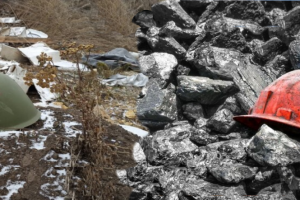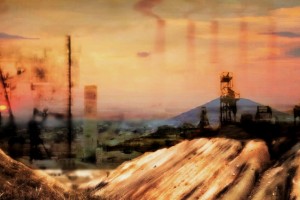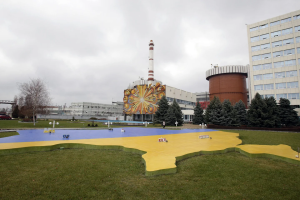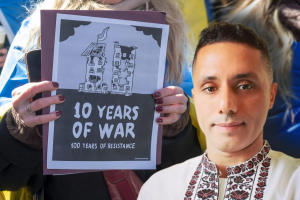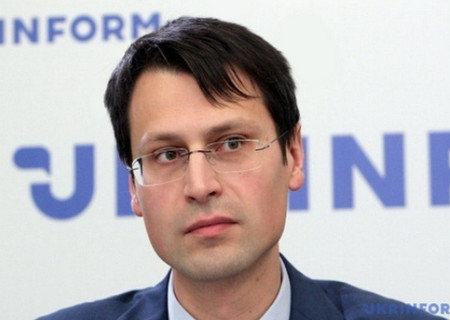
Executive Director

Russian leadership does not believes in rule of international law. Putin uses different diplomatic schemes and tools to divide and intimidate opponents, create short-term opportunities for domination and justification for use of force. If the western governments do not close their eyes on these facts and enforce Ukrainian defense and resilience, then the perspectives of peace in Europe can be saved and Ukraine will have a chance to end this war sooner than later.
Since the beginning of Russian invasion to Ukraine leaders of France, Germany, Israel and Turkey were at pains to facilitate talks between Moscow and Kyiv about terms of peace. While president Zelenskyy welcomed these efforts and showed commitment to peace talks, president Putin took ambiguous position. Domestically, he reiterated his intention to continue the war regardless to defeat near Kyiv and numerous war crimes. At the same time, Putin’s diplomats discuss different variants of peace resolution as if nothing is happening in Ukraine and Russia does not destroy Ukrainian lives, cities and economy.
To navigate joint western and Ukrainian diplomacy vis-à-vis Russian actions demands understanding Russian maneuvers regarding security issues in bilateral relations with Ukraine.
First, Kremlin use vague legal concepts that can be interpreted in different ways and allow avoiding legal obligation for itself while putting constraints on the opponent.
For instance, in November 2003 Russia achieved a success in persuading Ukrainian leadership to recognize Sea of Azov as “historically inner waters”. It allowed Russia to have in the sea as many navy ships as it wanted but prohibited presence of navy of other countries. Since Ukraine had no ships, except Border Guard small vessels, in the area, it resulted in huge military asymmetry, which Russia effectively used to threaten Ukraine’s Azov coast during and after seizure of Crimea in 2014.
A vague concept of neutrality
Today, in talks with Ukraine Russia is trying to impose a vague concept of “neutrality” as a major demand toward Ukraine. On the one hand, Russians refer to examples that are well-known to Europeans, speaking about “Austrian” or “Finnish” models of neutrality, regardless to different legal details and historical context of these cases. Moreover, Russians appeal to the ideas expressed by some former US diplomats like Henry Kissinger about Ukraine’ non-bloc status as compromise between Russia and the West.
On the other, Kremlin gives no details how it will respect neutrality of Ukraine and guarantee that it will not violate agreement in the future. Furthermore, Kremlin is silent about what Ukrainian territory will be covered by neutrality, since occupied Crimea, Donetsk and Luhansk regions, as well as large parts of Kherson and Zaporizhzhia region are under operative control of invading forces.
Territorial issue is important for a good reason. Respect of the internationally recognized borders of Ukraine is a key to implementation of any international legal agreement about future status of Ukraine, which involves Russia. Leaving Ukrainian occupied territories to Russia means that it can use disputes about boundaries of these areas to put pressure on Ukraine.
For instance, as it happened on the eve of the current war, Russia can stage false flag operations and provocations to claim that Ukraine does not follow agreement and use it to justify new invasion. When Russia avoids mentioning of these issues it means it wants to use occupation of Ukrainian territory as a bargaining chip in future rounds of peace talks.
Russias proxy players
Second, Kremlin creates proxy instruments and proxy players to mask its interests and advance proposals that are beneficial and derail negotiations if they put cost on Russia.
The brightest example were Minsk I (September 2014) and Minsk II (February 2015) agreements. In both cases, despite the facts of Russian direct military intervention and engagement with Ukrainian forces, Kremlin manufactured proxy “authorities” of the occupied Donetsk and Luhansk regions and used them as parties of the agreements while trying to position itself as mediator.
As a result, between 2015-2021, Russian military command could continue giving orders to troops, disguised as separatist militias while Russian diplomats directed separatist delegations during rounds of talks in Minsk.
Kremlin has been using same tactics in relations with the EU countries. However, Russian proxy players were state and private energy companies who established joint ventures with German, Austrian and Hungarian companies as proxy instruments of economic and political influence.
In the current situation, Russia does the same, creating new proxies. On April 8, Foreign Minister Lavrov saidthat Belarus should provide security guarantees for Ukraine in the future, once Kyiv affirms its neutral status.
This move demonstrates how Russia can undermine peace process using proxy players. Belarus regime is under EU and US sanctions for grave violations of human rights and its territory is used as a military base for Russian invasion. If Ukraine and western allies protest against engagement of Belarus Moscow will use it to call them unwilling of achieving peace.
However, if Belarus is allowed to enter negotiations Kremlin will use it to frame negotiations process. Belarus can present itself either as hawkish player, making other Russian peace proposals look more moderate and acceptable; or as a dovish player, pushing masked Russian proposal as compromises compared to hardline Moscow demands.
Russian threats
Third, Kremlin usually blackmails counterpart with high and severe cost of exit from negotiations without any kind of agreement that favors its interests.
Latest example is a Russian threat of military response to NATO and US when they rejected a proposal to give Russia legally binding security guarantees and agree with the Russian draft treaties on NATO forces in the Central and Eastern Europe.
Since 2014, Ukraine has constantly witnessed same Russian tactics during negotiations in Normandy format or Trilateral Contact Group in Minsk. After each Ukrainian refusal to make unilateral political concessions before a ceasefire, Kremlin increased military escalation in Donbas.
Now, Kremlin counts on the western reluctance to hot conflict with Russia, thus making direct threats to use force, even nuclear arms, if US, NATO and EU continue to support Ukraine. Recently, Turkey admitted it received complaints from Moscow about Bayraktar drones sales to Ukraine.
It is very likely that Kremlin will demand to stop weapons delivery to Ukraine as a prerequisite for peace talks. It is dangerous because it can influence powerful EU countries, like Germany or France, to consider such demands as serious, although Russia does not show intention to reduce attacks against military and civilian targets in Ukraine.
To conclude I want to remind an old diplomatic wisdom, expressed by XVII century French diplomat François de Callières. He once said that an international agreement that does not provide parties for mutual benefit could not last long; moreover, if the agreement does not meet this condition, it is not an agreement at all and contains grounds for its termination.
Russian actions in the recent past and today provide no evidence that its leadership believes in rule of international law, not speaking about rule of law at home. It uses different schemes and tools to divide and intimidate opponents, create short-term opportunities for domination and justification for use of force.
If the western governments do not close their eyes on these facts and enforce Ukrainian defense and resilience, then the perspectives of peace in Europe can be saved and Ukraine will have a chance to end this war sooner than later.


